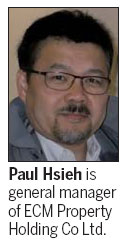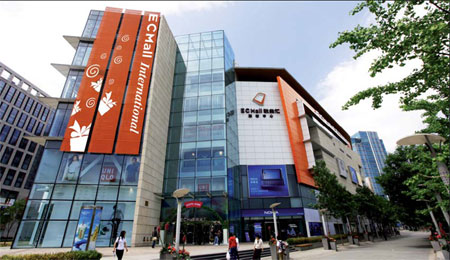The Mall Man

| ECMall is a place of "recreation" for many consumers in Beijing's high-tech Haidian district. Provided to China Daily |

Paul Hsieh has a vision for the future of his shopping center
On a Friday afternoon, Erwin Nooijens and his two friends from the Netherlands were looking for a pair of atheletic shoes in ECMall, a shopping center in Beijing's Zhongguancun area.
The three exchange students at Peking University had only arrived in Beijing 20 days ago. As the busy university semester had not yet started, they went out to have a look at their surroundings.
"We saw the shopping mall outside and just came in. We are little bit surprised that it looks really European style, and we are very familiar with the construction," Nooijens says.
The three twentysomethings happen to be ECMall's target consumers. At a time when shopping-center developers are ambitiously seeking opportunities for further expansion, the two-year-old mall seems to be focusing on its core consumer segment in Zhongguancun West.
The flow of customers in the capacious orange building demonstrates that ECMall's idea of caring for its core community in Zhongguancun, an area with many universities that has been labeled as the Silicon Valley of China, has had some success.
"Twenty kilometers away from us doesn't worry me," says Paul Hsieh, general manager of ECM Property Holding Co Ltd, explaining that he is focused on the area around Haidian district. Only a small percentage of the mall's customers come from the city's other districts.
The mall's 2012 revenue increased 15 percent from its first year of operation. Hsieh deduced that the performance is acceptable as he points out that a 5 to 10 percent growth for a mature shopping mall is sustainable for its long-term development.
"Obviously, we have climbed higher than the acceptable figure," he says.
Before ECMall opened, Hsieh conducted some market research and found that the demographic of the area is very young. White-collar workers, undergraduates and technicians account for most of the mall's customers. He also knew that the government was planning to put a subway interchange station for lines 10 and 4 on the opposite side of the mall.
"We decided to position the shopping center as a middle- to high-end one, focusing on providing lifestyle enjoyment for people living and working in the area," Hsieh says.
Walking into the building, which was designed by famed UK-based architectural firm Benoy, most of the guests wandering on each floor are in their 20s or 30s. Lovers are taking photos of each other; friends are talking about the goods. Customers in Costa Coffee, a British-based multinational coffeehouse on the first floor, are reading books or tapping away at their PCs.
"Most of them are young, vibrant, tending to mix and match their clothes," Hsieh says.
As for the business operation of ECMall, he says profits mainly come from leases. He also sets a sales target for each tenant.
"Once they pass the minimum line, the tenants have to share their profit with us," Hsieh says.
Of the 140 main brands in the mall, 70 percent of them come from overseas. Fashion brands, including H&M, C&A and Uniqlo, are popular with customers.
Hsieh says these brands record high sales figures, and their presence helps him develop and increase the brand awareness of ECMall. As such, these companies often negotiate a comparatively low rent.
Generally speaking, Hsieh can charge 15 to 18 percent of the extra profit from fashion retailers based on their location and performance.
"But as for restaurants and cafes, which have a lower profit margin, I charge a lower percentage," he says.
Upon completing his market research, Hsieh also found local residents were hungry for good restaurants. He developed a large food-and-beverage area that accounts for 35 percent of the mall's leasable area.
"The buffet restaurant chain Jinqianbao (Golden Jaguar) occupies the whole sixth floor, covering an area of 6,000 square meters. Customers of the restaurant range from children to elderly people," Hsieh says.
Across the road from ECMall is the Gate City Mall, also known as the Xinzhongguan Shopping Center. Hsieh says although the two buildings are both shopping malls, they are totally different. Gate City has the traditional boxlike look of most malls while ECMall is a triangular orange building with three atria.
"I make sure that we are not selling the same thing," Hiseh says.
His rich experience in the retail business, from his previous experience working with the Malaysia-based Parkson Retail Group Ltd and Hong Kong's Wing On department store, leads Hsieh to believe that the emergence of shopping malls in China happens mainly because more Chinese are entering the middle class.
"Once they are satisfied with the basic needs, such as food and clothing, they may pursue a higher standard of living. Shopping malls are one of the sources of their recreation," he says.
Nooijens and his friends say they know about 60 percent of the brands in ECMall. The prices are just like Europe, they say, although some of the items are a bit more expensive.
Therefore, at least in the near future, Hsieh plans to stick to serving the community and will not copy the approach of those who introduce a bevy of luxury brands into the mall.
yaojing@chinadaily.com.cn
(China Daily 09/28/2012 page13)
Today's Top News
- Experts share ideas on advancing human rights
- Japan PM's remarks on Taiwan send severely wrong signal
- Key steps to boost RMB's intl standing highlighted
- Sustained fight against corruption urged
- Xi calls for promotion of spirit of volunteerism
- Xi calls for promoting volunteer spirit to serve national rejuvenation































